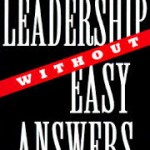 I wanted to review the book we are reading called “Leadership Without Easy Answers”, by Heifetz. He proposes that we face only 2 types of issues…. “technical” and “adaptive”. The title alone resonated with me. In my experience as an educator/principal, I have found that there is depth and implications to these issues, with no easy answers. I have also intuitively began to categorize them as “systematic” or “relational”. I compare that to Heifetz’s technical and adaptive types. Semantics. Heifetz also clarifies the difference between leadership and authority. One premise that I completely agreed with was the idea that leadership is an activity not a position. We as educators need to abandon the idea that “leaders are born, not made.” He insists, this idea fosters both self-delusion and irresponsibility in those who see themselves as “born leaders.” It also holds back the efforts of the so-called “non-born” leaders to reach potential and fulfill their purpose…sometimes becoming enabled.
I wanted to review the book we are reading called “Leadership Without Easy Answers”, by Heifetz. He proposes that we face only 2 types of issues…. “technical” and “adaptive”. The title alone resonated with me. In my experience as an educator/principal, I have found that there is depth and implications to these issues, with no easy answers. I have also intuitively began to categorize them as “systematic” or “relational”. I compare that to Heifetz’s technical and adaptive types. Semantics. Heifetz also clarifies the difference between leadership and authority. One premise that I completely agreed with was the idea that leadership is an activity not a position. We as educators need to abandon the idea that “leaders are born, not made.” He insists, this idea fosters both self-delusion and irresponsibility in those who see themselves as “born leaders.” It also holds back the efforts of the so-called “non-born” leaders to reach potential and fulfill their purpose…sometimes becoming enabled.
Heifetz stresses that leaders are confronted with two types of problems: technical, which can be solved by skill-set, expertise, and management. Adaptive problems, such as poverty, drug abuse, and racial tensions is the other type that requires a relational and social approach. Traditional management strategies are useful in dealing with technical problems, but in situations where beliefs and values come into play, technical solutions will only mask the problem. Trust, consistency, and time are the best solutions in improving adaptive problems.
Toxic school culture will trump even the best management.
This was a comment during our discussion that stuck with me because I have seen this challenge first hand. Adaptive challenges involve a disparity between values and circumstances….mostly beyond our control. To solve a complex problem, I must gather positive energy and resources to change circumstances. Sounds simple, but it forces adults out of their comfort zones and I’ve even seen some educators change their values, and in turn behaviors, as it becomes a difficult task…..sometimes with little hope to be seen. Old habits die-hard and at the simplest of pressures, individuals fall into paradigms that stifle growth. Leadership consists “not of answers or assured visions, but of taking action to clarify values.” Good leaders know how to stimulate and engage in efforts for shared vision and use the positive energy as motivation. We need to find the quick wins that exist in our efforts. Heifetz outlines five strategic principles of leadership:
- Diagnose the situation in light of the values at stake, and unbundle the issues involved
- Keep the level of distress within tolerable limits for doing adaptive work (“keep the heat up without blowing up the vessel”)
- Identify the issues that engage the most attention and counteract avoidance mechanisms such as denial, scapegoating, pretending the problem is technical, or attacking individuals rather than issues.
- Allow people to take responsibility for the problem, but at a rate they can handle.
- Protect those who raise hard questions, generate distress, and challenge people to rethink the issues at stake.
Heifetz then explains “leadership without authority.” We are not accustomed to distinguishing between leadership and authority, but there is a difference! While we usually focus attention at the top as it disperses down in hierarchy, leadership may more often emerge amongst and at the foundational level. This is so true in education. It takes the professional, in their area of expertise, regardless of authority to service the whole child. Leaders without authority,
“push us to clarify our values, face hard realities, and seize new possibilities, however frightening they may be.” ~ Ronald Heifetz
In the book’s final chapters, Heifetz discusses strategies for “staying alive.” The stresses of adaptive work are often overwhelming and can bring out the worst in people, he says. Leadership is demanding, and sometimes dangerous with or without authority. Leaders and authority figures get attacked, dismissed, silenced, and sometimes isolated. Heifetz’s recommends to leaders that they “get on the balcony” getting far enough above the fray to see the key patterns and power players. Leaders must distinguish between oneself and one’s role…..as long as values and behavior point to your true north, the negative energy will divert to its rightful owners! Leaders must identify and share the burden with partners and colleagues.
Be First to Comment